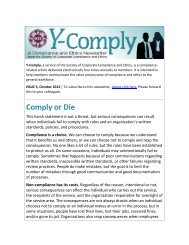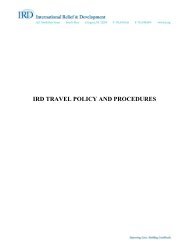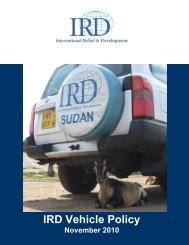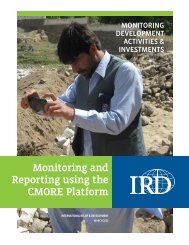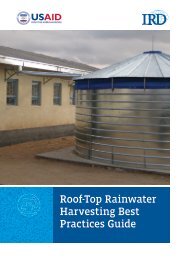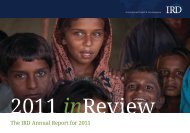IRD Vehicle Policy - International Relief & Development
IRD Vehicle Policy - International Relief & Development
IRD Vehicle Policy - International Relief & Development
Create successful ePaper yourself
Turn your PDF publications into a flip-book with our unique Google optimized e-Paper software.
<strong>IRD</strong> <strong>Vehicle</strong> <strong>Policy</strong><br />
November 2010
Title: <strong>Vehicle</strong> <strong>Policy</strong> Effective Date: 11/22/10<br />
Table of Contents<br />
Introduction .................................................................................................................................................2<br />
Start-up Activities .......................................................................................................................................3<br />
Driving Overview.........................................................................................................................................4<br />
Safety in <strong>Vehicle</strong>s........................................................................................................................................7<br />
<strong>Vehicle</strong>s and Transport ..............................................................................................................................8<br />
A. Documentation .................................................................................................................................8<br />
B. <strong>Vehicle</strong> Maintenance........................................................................................................................8<br />
C. <strong>Vehicle</strong> Equipment ...........................................................................................................................9<br />
D. Motor <strong>Vehicle</strong> Operation ................................................................................................................10<br />
E. Hired Drivers ..................................................................................................................................10<br />
G. Accidents........................................................................................................................................11<br />
H. Journey Procedures.......................................................................................................................12<br />
I. Check Points ..................................................................................................................................13<br />
J. Convoys .........................................................................................................................................14<br />
K. Armed Conflict................................................................................................................................16<br />
L. Preparations for Evacuation/Relocation.........................................................................................17<br />
Forms .............................................................................................................................................................<br />
* Note: <strong>IRD</strong> employees must follow procedure and use provided forms: other forms are obsolete and will<br />
not be accepted. If you do not use the correct forms you will be in violation of this policy.<br />
Please contact vehicles@ird-dc.org and CC’ your project backstop at HQ for any forms that you are<br />
missing or if, for any reason, any form needs to be tailored to your specific project.<br />
• <strong>Vehicle</strong> Log Requirements<br />
• Non-<strong>IRD</strong> Passenger Waiver<br />
• Security and Traffic Incident Report<br />
• Specific <strong>Vehicle</strong> Data<br />
• <strong>Vehicle</strong> Inspection Checklist<br />
• <strong>Vehicle</strong> Service Log<br />
• Trip Authorization Form<br />
• <strong>Vehicle</strong> Request Form<br />
• Contract with Fuel Supplier<br />
• Fuel Consumption Report Log<br />
Notice: A printed copy of this document may not be the latest version.<br />
Available online: https://portal.ird.org<br />
Updated: January 2011 2
Title: <strong>Vehicle</strong> <strong>Policy</strong> Effective Date: 11/22/10<br />
Introduction<br />
The <strong>IRD</strong> <strong>Vehicle</strong> <strong>Policy</strong> 1 is intended to provide guidance on all aspects of the use and maintenance of<br />
<strong>IRD</strong> vehicles and associated equipment and a series of instructions that must be adhered to at all times<br />
for the safety of <strong>IRD</strong> personnel. If any aspect of this policy is not understood or, for any reason, cannot<br />
be complied with, the Chief of Party/Country Director (COP/CD) must immediately seek further<br />
guidance and instruction from <strong>IRD</strong> Director of Risk Management and Global Security and not make any<br />
assumptions that could endanger the safety of <strong>IRD</strong> staff or allow a vehicle to be operated outside the<br />
parameters of the relevant donor’s regulations and policies.<br />
Start-up Activities<br />
All projects require some transportation to conduct business, so one of the first meetings in country will<br />
be to discuss this policy, vehicle acquisition (lease, purchase, and waiver requirements), staff use of<br />
vehicles, and related insurance requirements. Any other project vehicle specifications will be developed<br />
with the COP and based upon the donor and client requirements, the terms and conditions of the funded<br />
agreements as well as project needs. A vehicle control system will be established as soon as possible<br />
and before vehicles are in use, including a document file for each vehicle that will be comprised of<br />
registration and insurance certificates, shipping documents, accident reports, vehicle travel and<br />
maintenance logs, and any other essential documents related to the vehicle.<br />
Expatriates are not authorized to drive vehicles as a rule except in life threatening situations. In some<br />
countries expats may receive written authorization to drive from headquarters, and in certain emergency<br />
response start ups.<br />
There are three basic options for transport:<br />
1. Take local transport, such as taxicabs. This is an option if the project requires no or very few<br />
trips outside the city in which the project office is located, and excellent public transport is<br />
regularly available. If this is the most reasonable option, you may want to establish a<br />
relationship with a number of local drivers that can be called when needed so that you do not<br />
have to rely on random cab drivers in the city. To the extent possible make sure that you use<br />
licensed taxicabs. Frequently, local transportation, such as buses, may not be safe. Consult with<br />
HQ or local security officer before taking local transportation.<br />
2. Hire one or more drivers who provide their own autos to accommodate the travel needs of<br />
staff both within the project city and for longer-distance project trips. This may be the preferred<br />
option when it is difficult to purchase a U.S.-manufactured car in country or to bring one in. It is<br />
critical that project management monitor maintenance and service of the vehicles. In general,<br />
funds for maintenance and service are paid to the driver via the U.S. government-approved<br />
mileage rate, as translated into local currency. You may want to set up differential rates for<br />
intra-city vs. inter-city trips. <strong>Vehicle</strong> logs must be maintained so that travel documentation is<br />
available for support of billing and expenses and (where pre-approved by USAID) for personal<br />
use reconciliation for reimbursement back to the project. Cars and drivers should be in<br />
compliance with local laws related to vehicles such as insurance, registration, and/or licensing.<br />
Verify compliance by asking to see the documentation. Where possible, attempt to hire vehicles<br />
1 Sections adapted from <strong>IRD</strong> Security <strong>Policy</strong> unless otherwise noted<br />
Notice: A printed copy of this document may not be the latest version.<br />
Available online: https://portal.ird.org<br />
Updated: January 2011 3
Title: <strong>Vehicle</strong> <strong>Policy</strong> Effective Date: 11/22/10<br />
from rental agencies so that insurance issues are covered and an acceptable level of vehicle<br />
safety equipment is present. It should also be noted that some missions require the use of U.S.<br />
origin vehicles.<br />
3. Purchase one or more project cars for project travel. There are restrictions on the purchase<br />
of automobiles (see ADS 312.5.3) and USAID approval is required prior to purchase. Any cars<br />
that are purchased must be of U.S. origin unless a waiver from USAID is obtained prior to<br />
purchase. You should follow <strong>IRD</strong>’s procurement procedures. <strong>IRD</strong>’s Contracts and Grants<br />
office must be involved in any car purchase. (See form: <strong>Vehicle</strong> Rental Contract)<br />
As with many other issues, look to your client and other contractors for guidance concerning which<br />
option you choose.<br />
The remainder of this section pertains to situations in which there are project cars (either driver-supplied<br />
or purchased by the project).<br />
Driver Compensation. Driver contracts are generally for 40 hours per week. You may elect to stagger<br />
the work hours of drivers to allow transportation coverage before and after the standard office workday.<br />
Like other staff members, drivers are paid from the time they reach the office in the morning until they<br />
finish their last assignment at night. They are not compensated for the time required to drive to and from<br />
their home to the office each day unless the driver must provide transportation to and/or from the airport<br />
late at night or early in the morning. The project requires that all full-time drivers hold a valid driver’s<br />
license.<br />
Scheduling Ground Transportation. Each site determines its own system for managing the efficient<br />
scheduling and allocation of drivers to meet requests for local transportation. To the extent possible,<br />
trips should be planned and coordinated to ensure efficient use of vehicles.<br />
The project should name an individual who is responsible for scheduling vehicle use. This person is<br />
responsible for setting up systems to allow staff to request transportation and for administering those<br />
systems. The person who manages transportation is responsible for solving problems and seeking ways<br />
to accommodate everyone’s needs reasonably. (See all applicable forms)<br />
Driving Overview<br />
Safety is our first concern. The driver and his or her supervisor are responsible for the condition of the<br />
vehicle, and is expected to drive according to country-specific traffic regulations, road and weather<br />
conditions, and in accordance with these policies. The driver must be in possession of a valid driving<br />
license and have passed a simple driving test conducted by the transport/motor pool manager of the<br />
project. The driver should not drive when too tired or sick. Driving recklessly or under the influence of<br />
alcohol, drugs or other controlled substances is strictly prohibited and will result in immediate dismissal.<br />
Before leaving, the driver must ensure that s/he is familiar with the controls and the design of the<br />
vehicle. Furthermore, it is the responsibility of the driver to ensure that the condition of the vehicle is<br />
checked every morning, daily (see form: <strong>Vehicle</strong> Inspection Checklist) and the vehicle driving<br />
documents placed in each vehicle have been read and understood, including that the <strong>Vehicle</strong> Log has<br />
been correctly completed before departure and upon return. Project Managers should be responsible for<br />
ensuring drivers know the <strong>IRD</strong> policy, are obeying the rules, and carrying out inspections and log<br />
entries as required.<br />
Notice: A printed copy of this document may not be the latest version.<br />
Available online: https://portal.ird.org<br />
Updated: January 2011 4
Title: <strong>Vehicle</strong> <strong>Policy</strong> Effective Date: 11/22/10<br />
The COP/CD is responsible for appointing a suitably qualified person to manage and maintain the<br />
country’s vehicle pool and to ensure that all drivers (and passengers) comply with the <strong>IRD</strong> <strong>Vehicle</strong><br />
<strong>Policy</strong> at all times. Any person found not to be in compliance will be subject to disciplinary action.<br />
Daily <strong>Vehicle</strong> Logs. Drivers are required to maintain vehicle logs that give the details of each trip that<br />
will include:<br />
• Start of trip date and time.<br />
• Start of trip kilometers.<br />
• End of trip time.<br />
• End of trip kilometers.<br />
• Location at the start of the trip.<br />
• Destination at the end of the trip.<br />
• Passenger name(s) and signature for each leg of the trip, providing concurrence that the trip<br />
occurred as stated.<br />
• Reason for the trip.<br />
The daily vehicle log may be the same log that is used to show a driver’s regular and overtime hours<br />
(where applicable). The passenger in the vehicle must sign approval of the trip and acknowledge in<br />
writing if it is personal or official travel. If the passenger is a non-<strong>IRD</strong> staff member, they should sign a<br />
release form (See form: Non-<strong>IRD</strong> Passenger Release Form) Drivers should be counseled on their role in<br />
insisting that signing for travel be a routine part of a passenger’s responsibility. If a trip is requested by<br />
someone who will not be a passenger in the vehicle during the trip (e.g. the COP asks the driver to<br />
courier something to a destination, but is not physically accompanying the driver), the driver should still<br />
register this trip in the log, and bring the log to the individual to sign once the trip has been completed.<br />
(See forms: Journey Log, <strong>Vehicle</strong> Report Log, Fuel Consumption Report Log, and Services Log)<br />
<strong>Vehicle</strong> logs are a critical element in all audits and a favorite topic for audit as they are easily verifiable.<br />
For projects funded by USAID, that agency is strict in requiring that these be maintained, filled out, and<br />
reconciled regularly. USAID often requests unannounced review of vehicle logs, so the COP and the<br />
project site’s Finance and/or Administrative Manager must be sure that the procedures for vehicle logs<br />
are strictly maintained and followed.<br />
The driver is also responsible for driving in accordance with the normal driving regulations of the<br />
operating country regarding speed limits and should be fully aware that they are representing <strong>IRD</strong> at all<br />
times and perform and act accordingly, such as always being polite and courteous to other drivers and<br />
pedestrians, and parking the car in a safe place with the doors locked, windows closed and, where<br />
applicable, alarm activated. When parking overnight the vehicle is to be placed either in a guarded area<br />
or in an enclosed, locked area. Use of mobile phones when driving is actively discouraged, irrelevant of<br />
the country’s laws on the subject, only to be used when and if absolutely necessary.<br />
Key presses are to be situated in all field offices for staff to place vehicle keys when vehicles are not in<br />
use. Keys are not to be taken unless the relevant transport or Senior Manager has given approval.<br />
Project <strong>Vehicle</strong>s Donors are sensitive to how vehicles are used in projects. If you are working on a<br />
USAID project, check with your contractual obligations and with the USAID Mission to see what the<br />
vehicle control and acquisition policies are for your project. If in doubt, check with the <strong>IRD</strong> HQ<br />
Notice: A printed copy of this document may not be the latest version.<br />
Available online: https://portal.ird.org<br />
Updated: January 2011 5
Title: <strong>Vehicle</strong> <strong>Policy</strong> Effective Date: 11/22/10<br />
Contracts and Grants Department. USAID’s vehicle philosophy is that vehicles are to be used to further<br />
projects goals and outputs and not for the personal benefit of project staff or government counterparts.<br />
This restriction on use may also stretch to not allowing the vehicle to leave the country without USAID<br />
approval. If this is required for genuine project needs (e.g. working on a cross-border project), then<br />
ensure you have received written approval from USAID in advance of your travel and that you have all<br />
relevant documents for driving in a different country (e.g. insurance coverage).<br />
Personal Use of Project <strong>Vehicle</strong>s. Some projects may allow personal use of vehicles and some projects<br />
may not. With the exception of emergency situations, all personal use of project vehicles must be paid<br />
for by the employee at a fixed rate per mile, this includes home to work and work to home transport.<br />
The fixed rate per mile will vary by year. For U.S. government funded projects, check with the local<br />
U.S. Embassy for guidance on appropriate rates. For all emergency cases, the instance must be<br />
documented in writing (including retroactive COP/CD approval) and retained in the relevant vehicle and<br />
individual’s personnel file.<br />
Where the donor allows, the COP only may approve personal use of vehicles as long as prior approval is<br />
provided, and the requested personal use will not negatively affect the official needs of the vehicle the<br />
project implementation. At some project sites, (such as in Iraq or Afghanistan) security concerns may<br />
permit use of project vehicles for other than project needs. This use must be documented in the vehicle<br />
logs (as must every trip made by the vehicle) and any personal use of the vehicle must be billed to the<br />
individual, preferably at the end of each month, based on the official USG per mile or per kilometer<br />
cost. Any authorized personal use of vehicles by consultants must also be billed to the consultant prior<br />
to his or her departure from country. The wording “Personal Use” must also be entered alongside the<br />
relevant vehicle log entries.<br />
For USAID projects, this is an absolute and can be flagged in an audit if the policy is violated. Records<br />
should be kept of personal mileage on project vehicles as well as records of the employee reimbursing<br />
the project.<br />
The same procedures for reimbursement must be followed as outlined above for all personal use of<br />
project vehicles, including the recording of the appropriate entries into logbook.<br />
If the COP and donor-approved personal use of a vehicle is more of a long-term arrangement, the driver<br />
is to periodically (not less than weekly) submit a report to the relevant finance manager/officer giving<br />
details of the vehicle number plate, dates used and kilometers/miles driven and attach photocopies of the<br />
appropriate pages of the vehicle book and reimburse the relevant amount of money owed based on<br />
current USAID regulations. If more than one vehicle was used, this system applies to each vehicle used.<br />
The original vehicle log must also be submitted to the finance office and be initialed by the finance staff<br />
to document that the personal use has been paid for.<br />
It is recognized that field offices, housing locations, and security considerations for staff vary greatly<br />
and there may be some circumstances where reasonable accommodations must be made for staff to have<br />
regular transportation to eating facilities, laundry services, and so forth. These cases should be brought<br />
to the Director of Contracts and Grants and a determination made as to how to equitably manage the<br />
transportation needs and costs associated with the personal use of vehicles.<br />
Privately owned vehicles polices may vary by donor. USAID stipulates that one vehicle per expatriate<br />
staff can be shipped to a post assignment and return shipment at the end of their posting. No other<br />
reimbursement is allowed however, such as maintenance, repair, gas, insurance, etc. If the vehicle was<br />
purchased in country, USAID will not ship from a post. USAID Missions may have a policy that allows<br />
Notice: A printed copy of this document may not be the latest version.<br />
Available online: https://portal.ird.org<br />
Updated: January 2011 6
Title: <strong>Vehicle</strong> <strong>Policy</strong> Effective Date: 11/22/10<br />
one to use a vehicle on a cost-mileage basis while settling in. Check with the local Mission to determine<br />
their policy regarding in country use of POVs.<br />
Generally, POVs cannot be rented by the project except on an arms-length basis and market rates. This<br />
must be carefully documented for audit purposes<br />
<strong>Vehicle</strong> Insurance. Apply for vehicle insurance on all project vehicles, including personally owned<br />
vehicles, keeping in compliance with contract and country requirements. Determine country<br />
requirements for drivers’ licenses, including the need for an international drivers license and provide<br />
staff with any forms needed for local licenses. It goes without saying that comparison shopping should<br />
be undertaken looking at rates for full comprehensive and liability insurance.<br />
Insurance for POVs, including motorcycles should be in accordance with <strong>IRD</strong> and USAID (or other<br />
donor) regulations. All vehicles must be insured without exception. Detailed information about each car<br />
such as the VIN, model, make, and year, etc. should be registered in the form.<br />
The project pays for liability and collision insurance for all project-owned vehicles. It is the<br />
responsibility of the Finance or Administrator Manager or person delegated to be in charge of transport<br />
to keep track of the insurance coverage and to sure it is renewed before expiration. (See form: Specific<br />
<strong>Vehicle</strong> Data)<br />
Safety in <strong>Vehicle</strong>s 2<br />
Traffic and vehicle-related accidents are among the top causes of injuries and fatalities among<br />
international aid personnel. Included below are guidelines for basic vehicle safety, convoys, and<br />
appropriate responses to dangerous situations that can arise while traveling by vehicle. Although not<br />
every <strong>IRD</strong> project will need the level of security precautions listed below, the general guidelines for safe<br />
operation of vehicles for any project should be followed. In more secure countries, the Chief of Party<br />
will determine the level of security precautions to take in regards to vehicles. (See: Security and Traffic<br />
Incident Report)<br />
General Guidelines<br />
• Wear seat belts – Always.<br />
• Select primary and alternate routes that avoid checkpoints.<br />
• Vary routes and times.<br />
• Notify others of your travel time and destination and steps they should take in the event you do<br />
not arrive as scheduled.<br />
• Check the vehicle daily. <strong>Vehicle</strong>s must be well maintained.<br />
• Do not travel without an HF or VHF radio, first-aid kit, maps, compass, and other emergency<br />
supplies.<br />
• Have travel documentation in order. Always carry your international driver’s license or a valid<br />
license for the host country.<br />
• Require the driver to fill out a vehicle log after each use. A log should include drivers’ names,<br />
destinations, dates, and times and be kept in each vehicle.<br />
2 This section from <strong>IRD</strong> Security Manual Iraq - 2003<br />
Notice: A printed copy of this document may not be the latest version.<br />
Available online: https://portal.ird.org<br />
Updated: January 2011 7
Title: <strong>Vehicle</strong> <strong>Policy</strong> Effective Date: 11/22/10<br />
• Observe local driving laws and regulations.<br />
• Avoid night driving when possible.<br />
• Never let fuel tank fall below half full. Refuel at the end of each day, when possible.<br />
• Always travel with at least one other person.<br />
• Keep a spare key.<br />
• Never carry an unauthorized passenger.<br />
• Consider posting decals on your door or window indicating guns are not permitted in the<br />
vehicle.<br />
• Drive at the safest speed for prevailing conditions.<br />
• Keep doors locked.<br />
• Keep a minimum number of windows open (no more than five centimeters and only those<br />
windows near occupied seats).<br />
• Constantly check rear-view mirror.<br />
• Never leave vehicles unattended.<br />
Each new arrival will receive technical training, if necessary, in mine awareness, vehicle operation, and<br />
the operation of radio equipment. Curfews will be considered and/or implemented for times of travel by<br />
the Security Review Team or Designated Security Officer. No-go zones will be considered and/or<br />
implemented by the Security Review Team or Designated Security Officer for areas or places that may<br />
be specific targets, such as political buildings and/or certain restaurants/clubs.<br />
<strong>Vehicle</strong>s and Transport 3<br />
<strong>Vehicle</strong>s are working tools, a means of transportation and, in insecure environments, a means of<br />
escaping danger. It is, therefore, mandatory for management and staff to ensure the guidelines of vehicle<br />
management are practiced and followed by all.<br />
A. Documentation<br />
1. Each <strong>IRD</strong> owned and/or operated vehicle must contain the necessary and current documents<br />
denoting:<br />
Ownership<br />
Registration<br />
Insurance<br />
Any other papers required by the local government<br />
Note: In some environments, such as Iraq, it may be a danger to carry any documents that could<br />
identify the vehicle and the passengers with a specific organization. In these environments it<br />
would not be a requirement to carry the documents as specified.<br />
3 This Section adapted from Administrative Security <strong>Policy</strong> And Procedures July 2008: Section Six<br />
Notice: A printed copy of this document may not be the latest version.<br />
Available online: https://portal.ird.org<br />
Updated: January 2011 8
Title: <strong>Vehicle</strong> <strong>Policy</strong> Effective Date: 11/22/10<br />
2. Each <strong>IRD</strong> owned and/or operated vehicle must contain a policy letter from the Chief of<br />
Party/Country Director expressly stating the refusal to transport unauthorized persons or those<br />
persons who may be carrying firearms.<br />
B. <strong>Vehicle</strong> Maintenance<br />
Servicing and maintaining vehicles are an absolute must to keep a vehicle in good running<br />
condition and to prevent breakdowns. This is extremely important in areas of conflict.<br />
Each <strong>IRD</strong> Office will set up a logbook for each vehicle. The logbook will be used to record:<br />
a. Trip or daily mileage<br />
b. Inspections<br />
c. Maintenance<br />
d. Repairs<br />
Inspections:<br />
Inspections will be conducted on a daily basis by drivers or staff members operating the<br />
vehicles. A completed inspection should be noted in a logbook, noting any needed<br />
repairs/attention. Supervisors will inspect vehicles once a month, with copies of inspection<br />
sheets forwarded to the Chief of Party or Country Director.<br />
The items to be checked during daily and monthly inspections include:<br />
• Fuel level<br />
• Oil level<br />
• Radiator water level<br />
• Brake fluid<br />
• Power steering fluid<br />
• Fan belts<br />
• Battery fluid<br />
• Lights: headlamps, tail lights, blinkers and back-up<br />
• Tire tread and tire pressure<br />
• Spare tire<br />
• Tools<br />
• Windows and doors<br />
• First aid kit<br />
• <strong>Vehicle</strong> documents<br />
• Cleanliness of interiors<br />
Servicing and maintenance:<br />
May be done by qualified staff in certain circumstances. If serviced by staff, then vehicles must<br />
be checked by contracted mechanics at least every three months. If vehicles are US sources and<br />
Notice: A printed copy of this document may not be the latest version.<br />
Available online: https://portal.ird.org<br />
Updated: January 2011 9
Title: <strong>Vehicle</strong> <strong>Policy</strong> Effective Date: 11/22/10<br />
of US origin, the manufacturer’s manual must be followed and ‘approved’ repair shops used to<br />
maintain the US warranty.<br />
May be done by contracted mechanics.<br />
Items to be regularly serviced every three months/3,000 miles include:<br />
• Oil and oil filter<br />
• Fuel filters<br />
• Grease<br />
<strong>Vehicle</strong>s must be inspected before traveling long distances (over 30 miles) or on excursions<br />
outside of major cities, especially in zones of conflict.<br />
C. <strong>Vehicle</strong> Equipment<br />
1. Each <strong>IRD</strong> owned and operated or leased vehicle must contain the following items:<br />
a. Seat belts for all drivers and passengers (helmets for motorcycle riders).<br />
b. Owner’s manual<br />
c. Spare tire and tools to change tires<br />
d. A set of tools consisting of:<br />
• Flathead screw drivers (sizes 1 & 2)<br />
• Philips screw drivers (sizes 1 & 2)<br />
• Pliers (one)<br />
• Channel lock pliers (one medium size pair)<br />
• A set of metric or SAE sockets<br />
• Feeler gauges<br />
• Wire brush<br />
e. Spare parts:<br />
• Extra fan belt<br />
• Extra radiator hoses<br />
f. Tire gauge, tire pump, jack, tow rope, shovel, jumper cables, flares, reflectors<br />
and/or flags<br />
g. First aid kit<br />
h. Fire extinguisher<br />
i. In zones of conflict, each vehicle must also carry:<br />
• Three days food/water rations for each person.<br />
• Communication equipment<br />
D. Motor <strong>Vehicle</strong> Operation<br />
1. Anyone operating an <strong>IRD</strong> owned or rented vehicle must have a proper and acceptable driver’s<br />
license.<br />
Notice: A printed copy of this document may not be the latest version.<br />
Available online: https://portal.ird.org<br />
Updated: January 2011 10
Title: <strong>Vehicle</strong> <strong>Policy</strong> Effective Date: 11/22/10<br />
2. Each driver and passenger is required to wear a seatbelt while riding in vehicles.<br />
In some countries, such as Iraq, wearing a seatbelt identifies the wearer as a westerner and<br />
therefore a potential target. In these countries, a modification can be made by implanting a<br />
screw hook in the door post, which will allow the passenger to hook the shoulder strap. This<br />
will give the illusion of not wearing a seat belt, but will still allow the passenger to secure<br />
themselves with the lap belt.<br />
3. Each motorcycle rider is required to wear a strapped helmet.<br />
Failure to comply with the seatbelt/helmet policy may void a passenger’s eligibility for<br />
insurance in the event of an accident.<br />
4. Driving while under the influence of alcohol or drugs is expressly forbidden and is grounds for<br />
immediate dismissal from the organization.<br />
5. Drivers will operate the vehicles responsibly and will obey the rules of the road for the country<br />
in which they are operating the vehicle.<br />
E. Hired Drivers<br />
It is imperative to properly screen all drivers prior to hiring them. If possible, check with the<br />
local police, U.S. Embassy, or other group who may be of assistance in background checks.<br />
1. It is the driver’s responsibility to:<br />
a. Complete daily inspections<br />
b. Fuel the vehicle<br />
c. Clean the vehicle<br />
d. Report defects<br />
e. Keep a log of inspections and transports<br />
2. It should be explained to any potential driver that the following are grounds for immediate<br />
dismissal:<br />
a. Consumption of alcoholic beverages on the job or at any time when operating a motor<br />
vehicle.<br />
b. Falling asleep at the wheel.<br />
c. Theft of any kind.<br />
d. Use of the vehicle for personal reasons.<br />
e. Negligence resulting in an accident.<br />
G. Accidents:<br />
1. It is the policy of <strong>IRD</strong> to report all accidents to:<br />
a) The local authorities<br />
b) The appropriate embassy<br />
c) <strong>IRD</strong> Chief of Party or Country Director<br />
Notice: A printed copy of this document may not be the latest version.<br />
Available online: https://portal.ird.org<br />
Updated: January 2011 11
Title: <strong>Vehicle</strong> <strong>Policy</strong> Effective Date: 11/22/10<br />
d) <strong>IRD</strong> Director of Risk Management and Global Security<br />
e) local Security Staff<br />
2. Depending on the country in which the accident occurs, you may or may not want to stop when<br />
involved in an accident, even when people are injured. In some countries, stopping may result in<br />
your personal injury or death from the local people at the scene. Keep in mind that someone<br />
may have staged the accident as part of an ambush or kidnapping…possibly yours.<br />
If it is safe to stop, render first aid immediately, if allowed to do so. Some countries forbid an<br />
individual to provide first aid unless they are licensed and many countries do not have a<br />
“Good Samaritan Law.” Wait for the police to arrive, but remember, in some countries you<br />
may have to go get them. If the vehicle is incapacitated<br />
• Remove all <strong>IRD</strong> and other property from the vehicle (cameras, laptop, personal<br />
possessions etc).<br />
• Wait for police to arrive/arrange for them to attend the accident.<br />
• If possible, take photographs of the damaged vehicle(s) and the locale of the accident.<br />
• If not impounded by the police, arrange for the vehicle to be transported to the nearest<br />
<strong>IRD</strong> office. If it is impounded, make every effort to obtain an official receipt and<br />
telephone number and contact details of the police facility housing the vehicle.<br />
• Once back at the <strong>IRD</strong> office, start to prepare repair estimates.<br />
• Ensure appropriate entries are made in the vehicle log recording the particulars of the<br />
vehicle at the time of the accident (mileage, tools/equipment etc) for checking later.<br />
If it is not safe to stop:<br />
a. Immediately contact your supervisor and a close friend. Advise them of the situation and<br />
that you are going to the police station to report the incident.<br />
b. Go to the police station and make a report.<br />
• Tell the police you were “involved” in an accident.<br />
• Tell the police the location<br />
• Tell the police if there were any injuries<br />
• Provide your driver’s license and any other required documents<br />
• DO NOT try to explain what happened or justify your actions. Keep in mind that<br />
ANYTHING you say can and will be used against you.<br />
c. <strong>IRD</strong> Chief of Party/Country Director or other supervisors who are notified of an accident<br />
involving injuries (as described above in section “2”) will immediately (within 6 hours)<br />
contact the Director of Risk Management and Global Security.<br />
Notice: A printed copy of this document may not be the latest version.<br />
Available online: https://portal.ird.org<br />
Updated: January 2011 12
Title: <strong>Vehicle</strong> <strong>Policy</strong> Effective Date: 11/22/10<br />
3. Accident Reports<br />
a. An initial accident report must be filed by email or fax with the <strong>IRD</strong> Director of Risk<br />
Management and Global Security within 24 hours of the incident. (See form: Security<br />
Incident Report Form and Security Incident Supplemental Report)<br />
b. Depending on the severity of the situation, the <strong>IRD</strong> Chief of Party or Country Director<br />
may request the assistance of the <strong>IRD</strong> Director of Risk Management and Global Security<br />
in conducting an appropriate investigation of the accident for the protection of <strong>IRD</strong> and<br />
the staff involved in the incident.<br />
H. Journey Procedures<br />
Preparing for a journey, even short ones, can make the difference between safely arriving at<br />
your destination or not arriving at all. Plan and prepare for all trips to ensure your safety, the<br />
safety of others, and the safety of the mission.<br />
1. Journey Plans<br />
a. Prior to leaving <strong>IRD</strong> premises on any journey greater than 30 miles distance, a journey<br />
plan must be filed with the Chief of Party or his/her designee in charge of transport. (In<br />
zones of conflict, a journey plan must be filed in accordance with the rules set forth by<br />
the Designated Security Officer.)<br />
b. Journey plans will include:<br />
i. The license plate number and <strong>Vehicle</strong> Identification Number (VIN) of the<br />
vehicle to be used.<br />
ii. The names of all persons on the journey<br />
iii. Proposed departure time<br />
iv. Planned stops<br />
• Estimated times of arrival at each stop<br />
• Estimated time of departure from each stop.<br />
v. Arrival time at final destination<br />
2. Journey Preparations<br />
a. Prior to leaving <strong>IRD</strong> premises, each vehicle (including rented vehicles) will be inspected:<br />
• To ensure the maintenance has been properly maintained<br />
• To determine all the necessary documentation is in the vehicle<br />
• To ensure the required equipment is in the vehicle<br />
• To ensure there is no illegal contraband on board.<br />
Note: Passengers may be asked to show the contents of any personal bags to ensure there are<br />
no illegal items in them. This is a courtesy, do not be offended. You do not want to be<br />
surprised at a checkpoint by someone who has an illegal substance in their personal baggage.<br />
Keep in mind that if contraband is found, everyone in the vehicle and/or on the journey has a<br />
problem.<br />
3. Security contacts:<br />
Notice: A printed copy of this document may not be the latest version.<br />
Available online: https://portal.ird.org<br />
Updated: January 2011 13
Title: <strong>Vehicle</strong> <strong>Policy</strong> Effective Date: 11/22/10<br />
a. Lengthy or overnight journeys will require security contacts with the Chief of<br />
Party/Country Director or local <strong>IRD</strong> transport manager on a basis of two times a day<br />
(minimum).<br />
b. Regular security contacts with the Chief of Party/Country Director or local <strong>IRD</strong> transport<br />
manager will be conducted on an hourly basis in zones of conflict or as directed by the<br />
Designated Security Officer.<br />
c. Security contacts with the local <strong>IRD</strong> transport manager will be conducted prior to and<br />
after passing through any police or military checkpoints.<br />
I. Check Points<br />
It is extremely important to recognize that there are different types of checkpoints. Under<br />
normal conditions, checkpoints are used to verify the safety of the vehicle, the authority of<br />
drivers to operate vehicles, to look for stolen vehicles, and to verify vehicle documentation.<br />
In insecure areas, checkpoints are established to identify vehicles, personnel, and determine the<br />
reason for transiting the area. These checkpoints also serve to detect the transport of illegal<br />
weapons, explosives, and combatants.<br />
It is potentially dangerous to dictate a set of hard rules and regulations pertaining to<br />
checkpoints, but there are some basic rules to help you through them.<br />
1. Before traveling, check with others to determine any local checkpoint procedures in the area to<br />
which you are traveling.<br />
2. During the approach, quickly appraise the situation and choose a response:<br />
a. Proceed to the checkpoint if everything looks appropriate<br />
b. Turn around (if possible—keep in mind this may endanger you)<br />
3. Determine one spokesperson for the vehicle or convoy before approaching a checkpoint and let<br />
that person speak for the group.<br />
4. Take off sunglasses, if applicable, before the approach.<br />
5. Turn off the radio or music player.<br />
6. If stopped at night, turn off headlights and turn on the interior lights as you approach. This is<br />
done so the police or military can see you are not a threat.<br />
7. Stop if required to do so (recognized NGO vehicles may be waived through).<br />
8. Be friendly, polite, cooperative, and ALERT!<br />
a. Keep in mind that these people are usually armed and have the authority to ruin your day.<br />
b. Keep in mind that soldiers may be stationed at a checkpoint for long periods of time.<br />
Take the time to get to know them. It may be worth your while on future excursions.<br />
9. Provide all documents requested. DO NOT HAND THEM OVER (unless you have to). YOU<br />
MAY NOT GET THEM BACK. Use copies if acceptable.<br />
10. Keep your hands visible at all times. Do not make sudden or furtive movements, like reaching<br />
in a jacket where they think a gun might be hidden. You may get shot.<br />
Notice: A printed copy of this document may not be the latest version.<br />
Available online: https://portal.ird.org<br />
Updated: January 2011 14
Title: <strong>Vehicle</strong> <strong>Policy</strong> Effective Date: 11/22/10<br />
11. If vehicle and personal belongings are searched, watch closely to ensure nothing is stolen or<br />
planted in the vehicle.<br />
12. As you pass through any checkpoint, keep a reasonable distance between vehicles so that if one<br />
vehicle encounters problems, others may escape or call for help via radio.<br />
NOTE: Do not leave the planned path or roadways. Driving off road increases the possibility of<br />
encountering mines, unexploded ordnance and criminal activity. Leaving the planned path<br />
makes it more difficult to find you.<br />
NOTE: If journeys are repetitive, vary the routes (if possible). Routine routes increase the<br />
chance for victimization.<br />
NOTE: It is up to the CD/COP whether or not to institute the two-vehicle rule e.g. in certain<br />
difficult areas, travel can only be undertaken with a minimum of two vehicles traveling<br />
together.<br />
J. Convoys<br />
Prior to arranging convoys, one must consider the image and target of opportunity projected by<br />
several high value vehicles traveling together, carrying loads of expensive commodities and<br />
driven by healthy, well-dressed persons and/or foreigners. It may be safer to break the convoy<br />
into smaller segments.<br />
1. If convoys are used:<br />
a. Limit the size of the convoy to no more than eight vehicles.<br />
b. Determine a convoy leader.<br />
c. Check with local authorities to see if special permission is necessary to travel in this<br />
manner.<br />
d. If possible, reconnoiter the route(s) prior to departure.<br />
e. Prepare contingency plans:<br />
• Determine what to do in the event one vehicle breaks down.<br />
• Never leave a person over night with the vehicle.<br />
• Consider abandoning the vehicle and any goods that cannot be switched to another<br />
vehicle.<br />
f. Do not travel after dark.<br />
g. File a journey plan.<br />
h. Decide on the position of each vehicle in the convoy.<br />
• Place slower vehicles in the front of the convoy.<br />
• Place one radio equipped vehicle in the front (second position) and one in the back<br />
(next to last). If only one vehicle is radio equipped, place it in the back.<br />
• Medical units, if included, should be placed towards the middle or rear.<br />
• <strong>Vehicle</strong>s carrying spare parts should go in the middle or back of the convoy.<br />
Notice: A printed copy of this document may not be the latest version.<br />
Available online: https://portal.ird.org<br />
Updated: January 2011 15
Title: <strong>Vehicle</strong> <strong>Policy</strong> Effective Date: 11/22/10<br />
• Place the convoy leader in the front radio car.<br />
2. Convoy procedures<br />
a. Have all vehicles arrive at the departure point two hours ahead of time.<br />
b. Each vehicle must be inspected:<br />
• For fuel levels<br />
• For mechanical reliability<br />
• For documentation<br />
• For required equipment<br />
• For contraband<br />
NOTE: Written documentation of the inspection must be on file with the transport<br />
manager prior to the convoy’s departure.<br />
c. Each person on the journey must be briefed on:<br />
• The destination<br />
• Planned stops<br />
• Departure and arrival times for each stop and the overall journey<br />
d. Drivers must be instructed to keep a specified distance between vehicles. The distance<br />
should be no less than 30 feet or 10 meters.<br />
K. Armed Conflict<br />
In zones of conflict or in insecure areas, it is possible to be caught in a combat situation. Your<br />
response to combat situations may depend on whether you, your vehicle, or your organization is<br />
considered a target for any of the combatants. Chances are, you personally are not a target.<br />
Nonetheless, you could be in danger.<br />
NOTE: In some cases staff will be required to wear personal protection equipment such as a<br />
helmet and body armor. The determination will be made by the Designated Security Officer,<br />
Security Focal Point, or other hired security contractor. This is a non-negotiable requirement for<br />
travel when specified.<br />
1. If shooting is encountered:<br />
a. Drive through the area if the route is clear. If the shooting is in front of you, reverse out<br />
or turn around and leave the area. Be cautious, the sides of the road may be mined.<br />
b. Keep in mind that a moving target is difficult to hit. Remember speed while driving off is<br />
not necessarily going to provide protection. Drive with care when leaving to avoid<br />
wrecking the vehicle.<br />
c. If surrounded by shooting, seek cover or concealment. Remember ditches may be mined.<br />
• Concealment hides you, but does not protect you from bullets.<br />
• Cover hides you and protects you.<br />
2. If shelling or bombing is encountered:<br />
Notice: A printed copy of this document may not be the latest version.<br />
Available online: https://portal.ird.org<br />
Updated: January 2011 16
Title: <strong>Vehicle</strong> <strong>Policy</strong> Effective Date: 11/22/10<br />
a. Stop, take the radio if feasible, and take cover as far from the vehicle as possible.<br />
b. Stay behind cover until you are sure the danger has past.<br />
c. Go back to your vehicle and try to establish radio contact, if possible.<br />
d. Leave the area immediately.<br />
NOTE: If working in zones of conflict, make sure the vehicle is equipped with appropriate<br />
protective gear, such as helmets and flak jackets. Make sure all gear is clearly marked with<br />
the agency’s logo.<br />
Remember to be observant and be alert. It may save your life and the lives of others.<br />
L. Preparations for Evacuation/Relocation<br />
1. Communications<br />
Emergency communications are a vital link to the successful implementation of an evacuation<br />
or relocation plan. The Chief of Party, Country Director, or SFP/DSO shall ensure that all<br />
evacuation vehicles are equipped with radio equipment or some means of communication if<br />
the Country/Regional security situation require them. For questions consult <strong>IRD</strong> Director of<br />
Risk Management and Global Security<br />
2. <strong>Vehicle</strong>s<br />
<strong>Vehicle</strong>s will also play a major factor in any evacuation. The SFP/DSO shall complete a daily<br />
check of vehicles. This check should be in accordance with the procedures outlined in the<br />
<strong>Vehicle</strong> and Transport Section of this manual to:<br />
a. Ensure all vehicles are in good operating condition.<br />
b. Ensure all vehicles are properly fueled each day.<br />
c. Ensure all required equipment is on board each vehicle.<br />
3. Evacuations<br />
In the event evacuation to a second country is necessary, the Security Focal Point or<br />
Designated Security Officer will determine the asylum procedures for the destination country.<br />
• Make sure this country has ratified the 1951 UN Convention on refugees.<br />
• They accept refugees.<br />
Notice: A printed copy of this document may not be the latest version.<br />
Available online: https://portal.ird.org<br />
Updated: January 2011 17


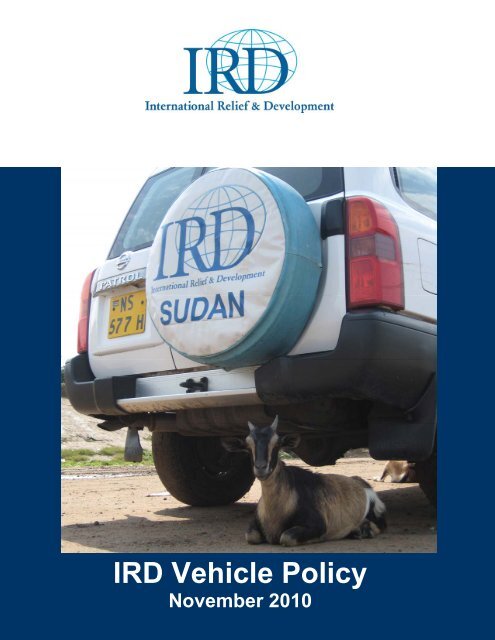
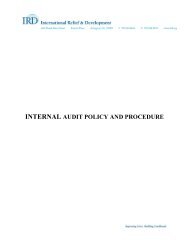
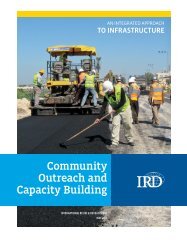
![Guide bonne pratique production d'oignon qualité_VF_4_2411012[1]](https://img.yumpu.com/23506639/1/184x260/guide-bonne-pratique-production-doignon-qualitac-vf-4-24110121.jpg?quality=85)

